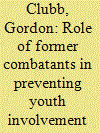| Srl | Item |
| 1 |
ID:
092404


|
|
|
|
|
| Publication |
2009.
|
| Summary/Abstract |
In today's global landscape, the success of interfaith initiatives is ascertained when their intended aim is envisioned and clarified. This article claims that the truest aim of interfaith dialogue in global perspective is the mutual transformation of cultural and religious realities, maintaining that when this vision becomes the underpinning informing the context of dialogue then interfaith engagement is elevated to an authentic spiritual practice effective across religious borders, assuring its destination in the advancement of intercultural relations and culture in general. Today, interfaith dialogue ought to focus more on common responses to global issues rather than differences among traditions; unimpeded, it can then engage mutual transformation for the benefit of all, achieving also significant steps toward transforming stultifying paradigms of present interreligious discourse. Positive change forwarding harmonious coexistence is an ongoing process involving the work of many generations. Steadfast youth involvement in interfaith dialogue is deemed imperative for sustainable harmony and peace.
|
|
|
|
|
|
|
|
|
|
|
|
|
|
|
|
| 2 |
ID:
145823


|
|
|
|
|
| Summary/Abstract |
The article engages with emerging debates on the potential role returning Islamic State fighters may have in preventing violence and whether nonviolent radical ideology acts as a conveyor-belt or firewall to violence. Rather than focusing on former combatant ideologies, it demonstrates how framing processes—not ideology per se—are more salient indicators of whether former combatants will act as conveyor-belts or firewalls to violence. The analytical framework developed for analyzing framing processes is then applied to the case of Northern Ireland. It argues that ideology shapes and constrains the type of antiviolence framing that may emerge, which provides a middle ground between the two perspectives in the literature. Furthermore, the article highlights the importance of network structures, incentives, and opportunities insofar as these can shape antiviolence framing and improve resonance among audiences. While recognizing the differences between cases, the framework is then used to argue that former Islamic State combatants can play a preventative role depending on whether their antiviolence framing is based on durable structural conditions, de-glamorizes violence, and is supported by networks that incentivize its diffusion—not on whether they have denounced their ideology.
|
|
|
|
|
|
|
|
|
|
|
|
|
|
|
|